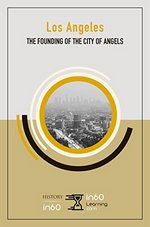 The Founding of Los Angeles: Before the Birth of Hollywood
The Founding of Los Angeles: Before the Birth of Hollywood
by in60learning
Series: in60LearningKindle Edition, 37 pg.
in60Learning, 2018
Read: April 28, 2018

“The final story, the final chapter of western man, I believe, lies in Los Angeles.” – Phil Ochs
This chapter epigraph reflects the obsession that so many have with Los Angeles, which is why we have a book about its founding, and not the founding of Seattle or Topeka.
When this book says “Before the Birth of Hollywood,” it means it — it starts as far back as 8000 B.C. with the Chumash people, tracing the various Native American groups to control the area, before eventually getting to the Spanish explorers and their descendants. From there they trace the various phases of Spanish rule of the area, followed by the Mexican rule and then eventually the transition to U. S. rule.
Through each era, the authors explore the cultural, religious, and economic lives of those in the greater L.A. area. I was vaguely aware of the Spanish and Mexican rule, but it didn’t take much reading in this book to realize how vague my awareness really was. This is truly interesting information, and I’d probably enjoy reading longer works on it.
I do have one quibble with the book — when discussing the ways the Spanish brought their own culture to the region, the book states: ” Spanish settlers, who had arrived in America to claim the land for themselves, converted the aboriginal people to Christianity and put them to work. There is some debate over whether they were forced into being baptized or impressed by the skills possessed by the Europeans and lured into doing so with the promise of knowledge and protection.” That bothers me. Why are those the only two options? Why couldn’t the converts be converted because they were convinced of the truth of Christianity? Or because they realized their own understanding of religion was deficient in comparison?
Quick read, that gives (at least) the impression of some sort of depth to the very focused topic. An easy read that offers a good deal of information that’s easily digested in a few minutes. Again, footnotes/endnotes and/or a bibliography/suggested reading list would be welcome additions to this book so the reader can follow up with something more in depth. Another good entry in a very helpful series.
—–


